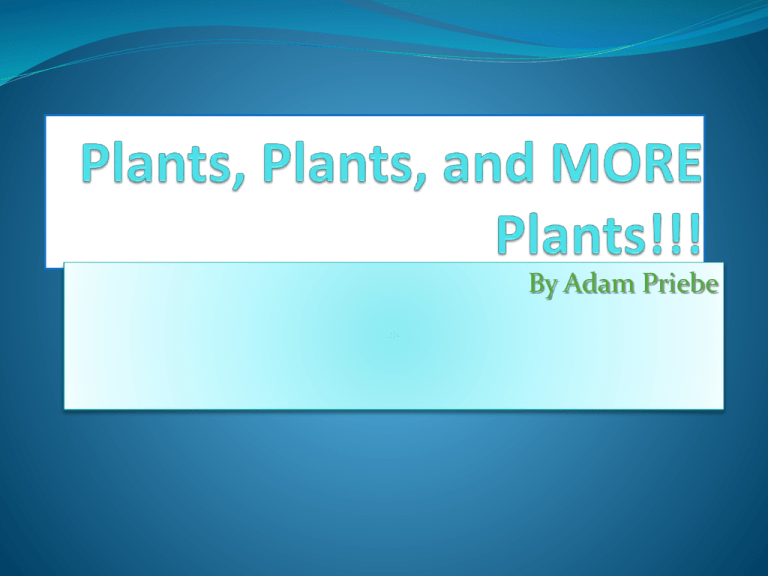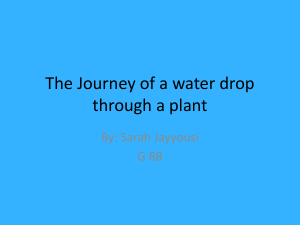Plants, Plants, and MORE Plants!!!
advertisement

By Adam Priebe Plant Cell Parts Vocabulary Nucleus- controls the functions in cell Nucleolus- Makes the ribosomes Cilia- hair-like structures that help the cell move (goes all around cell and is ONLY in animal cells) Plant Cell Diagram Mitochondria- Fuel the cell and give it energy Ribosomes- Make the proteins Lysosomes- hold enzymes (ONLY in animal cells) Smooth Endoplasmic Reticulum (SER) - Stores ions Rough Endoplasmic Reticulum- Packages proteins / lipids Cell Membrane- Supports the cell; keeps it in one piece, made of phospholipid bilayer Cell Wall- Located ONLY in plant cells, this gives them additional support and helps them keep their shape. Like the cell membrane, it goes around the whole cell right outside it. Both in plant cells Cytoplasm- Jelly-like substance filling the parts of the cell that are not organelles Plant Cell Diagram Types of Plants • There are many types of plants, but the two main categories are vascular and nonvascular. VASCULAR PLANTS Vascular plants have a system of tubes that carry nutrients through the plant. They also have true roots, unlike non-vascular plants, which only have rhizoids (which look like roots but do not carry nutrients or water). They use roots to get water, are generally larger and higher up than non-vascular plants, and have phloem and xylem (which you will learn about later). Non-VASCULAR PLANTS Non-vascular plants, on the other hand, have NO tubes to carry water (instead they use osmosis, where the nutrients will move from where the plant already has them to places where it doesn’t), are smaller and closer to the ground, have NO phloem or xylem, and reproduce by spores. Phloem and Xylem ...but what exactly is phloem, and what the heck is xylem? Before we can learn what phloem and xylem are, we must first understand the different types of roots. There are two main types: monocotyledon (monocot) and dicotyledon (dicot). Monocots generally have the major veins (the tubes that carry water and nutrients trough them) parallel to each other, running in a straight line. They also are more likely to have fibrous roots, the roots that will branch off of each other with no apparent main root, than tap roots, where the other roots branch off from a main one. Another difference is that monocots have only one cotyledon (seed leaf), while dicots have two cotyledons. Now, back to phloem and xylem. Phloem is the tissue in the plant that sends nutrients and water from the leaves downward. Xylem sends the nutrients from the roots upward. There are three main types of roots: • Tap roots- Roots that branch off from one main root (such as carrots) • Fibrous roots- Roots that branch off from each other with no apparent “lead root” • Adventitious roots- Roots that come slightly above the ground Fibrous Roots Tap Roots Adventitious Roots *Photosynthesis = How plants get energy from the sun, CO2, and Light Energy. How it works: 1) Light energy, water, and carbon dioxide (CO2) enter the plant. 2) The plant’s chloroplasts undergo photosynthesis and turn the things from step one into oxygen and glucose (the plant’s food) 3) We breathe in the oxygen that the plant outputs. This is absorbed into the plant, and the cycle happens over and over again. Photosynthesis Diagram Plant morphology = The study of the structure of plants Also called phytomorphology There are two main systems in plants: 1) The root system- The roots in plants • This serves many purposes including: - Keeps the plant anchored to the ground - Absorbs nutrients from the soil - Stores water 2) The shoot system- The stems, leaves, and flowers in plants • This serves many purposes as well including: - Keeps the plant upright - Reproduction - Transports nutrients around the plant - Stores nutrients and water Two different systems in plants Can you identify the two different systems in the diagram at right?






